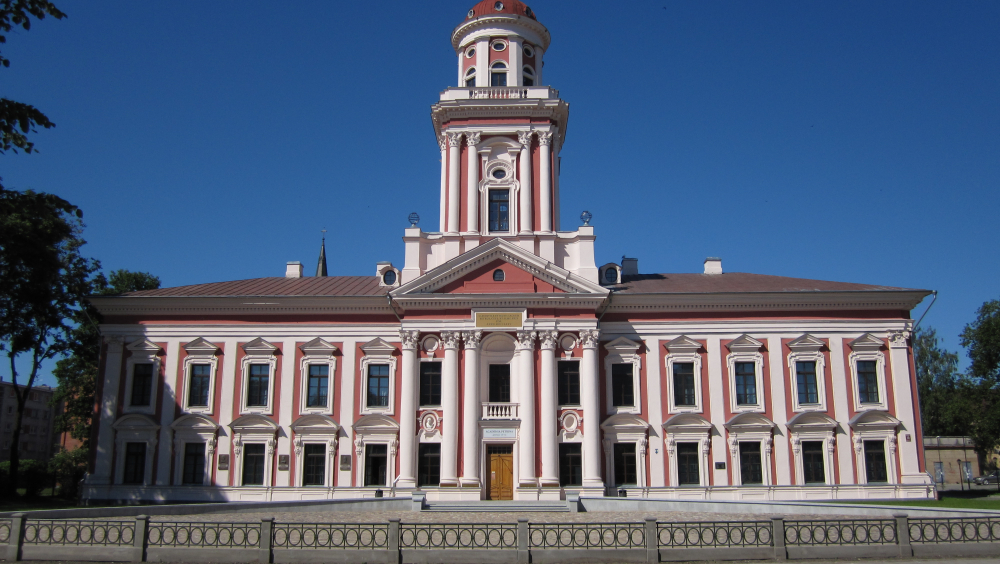The temple of knowledge
Short history of Ģederts Eliass'Jelgavas History and Art Museums building, Academia Petrina, who started as school and still educates people as a museum.
“SAPIENTIAE ET MUSIS SACRUM PETRUS KURL. ET. SEMG. DUK. POS. ANNO MDCCLXXV” (FOR SCIENCE AND ART THIS TEMPLE WAS BUILT BY DUKE PETER OF COURLAND AND SEMIGALIA DUCHY IN 1777) – these words decorate the entrance of Ģederts Eliass’ Jelgava’s History and Art Museum. In the beginning this building served as first higher education facility in Latvia’s territory. Built in 1775 Academia Petrina also known as Peter’s Academy has seen the best and the worst of what humanity is capable of. It has lived through wars, where it was almost destroyed, it has “raised” important political and cultural figures for Latvia, Lithuania and Poland, such as, first president of Latvia Jānis Čakste, first president of Lithuania Antanas Smetona, father of Dainas Krišjānis Barons, who is known for systematization Latvian folksongs, and famous Latvian painter Ģederts Eliass, whose name the museum bears. There are many more cultural and/or political figures who influenced future of their countries and development of national identity. In the beginning of 17th century necessity for higher education institution in Duchy of Courland and Semigalia became more and more obvious. 150 years later last duke of Courland and Semigalia Peter von Biron was influenced by enlightenment ideas and decided that it was finally time to open academy. And so he did… First, duke gave up his residence in the city for new school, second, building and maintenance cost was payed only by duke himself. Baroque style building with Classicism elements was designed by Danish architect Severin Jensen (1723-1809). Through the exterior architect perfectly revealed buildings spirit of knowledge – four busts of Ancient Greek thinkers, Socrates, Plato, Aristotle, Homer, looked over the main entrance. Because of harsh historical events, unfortunately, nowadays only one thinker remains in its place. When Duchy of Courland and Semigalia became part of Russian Empire, Academia Petrina also changed its status from academy to first university Universitatis Mitaviensis, but again history took its turn and Universitatis Mitaviensis lasted only for 100 days. Despite losing status as a university it continued to work as a gymnasium Gymnasium Illustre, afterwards until the First World War it was known as Male Gymnasium of Jelgava. Although, Academia Petrina now is not a school per se in 21st century, the main idea of being a temple of knowledge and art has remained unchanged. This building contains evidence of historical events and personas, magnificent pieces of artwork, it still continues to educate and fold young minds.
“SAPIENTIAE ET MUSIS SACRUM PETRUS KURL. ET. SEMG. DUK. POS. ANNO MDCCLXXV” (FOR SCIENCE AND ART THIS TEMPLE WAS BUILT BY DUKE PETER OF COURLAND AND SEMIGALIA DUCHY IN 1777) – these words decorate the entrance of Ģederts Eliass’ Jelgava’s History and Art Museum. In the beginning this building served as first higher education facility in Latvia’s territory. Built in 1775 Academia Petrina also known as Peter’s Academy has seen the best and the worst of what humanity is capable of. It has lived through wars, where it was almost destroyed, it has “raised” important political and cultural figures for Latvia, Lithuania and Poland, such as, first president of Latvia Jānis Čakste, first president of Lithuania Antanas Smetona, father of Dainas Krišjānis Barons, who is known for systematization Latvian folksongs, and famous Latvian painter Ģederts Eliass, whose name the museum bears. There are many more cultural and/or political figures who influenced future of their countries and development of national identity. In the beginning of 17th century necessity for higher education institution in Duchy of Courland and Semigalia became more and more obvious. 150 years later last duke of Courland and Semigalia Peter von Biron was influenced by enlightenment ideas and decided that it was finally time to open academy. And so he did… First, duke gave up his residence in the city for new school, second, building and maintenance cost was payed only by duke himself. Baroque style building with Classicism elements was designed by Danish architect Severin Jensen (1723-1809). Through the exterior architect perfectly revealed buildings spirit of knowledge – four busts of Ancient Greek thinkers, Socrates, Plato, Aristotle, Homer, looked over the main entrance. Because of harsh historical events, unfortunately, nowadays only one thinker remains in its place. When Duchy of Courland and Semigalia became part of Russian Empire, Academia Petrina also changed its status from academy to first university Universitatis Mitaviensis, but again history took its turn and Universitatis Mitaviensis lasted only for 100 days. Despite losing status as a university it continued to work as a gymnasium Gymnasium Illustre, afterwards until the First World War it was known as Male Gymnasium of Jelgava. Although, Academia Petrina now is not a school per se in 21st century, the main idea of being a temple of knowledge and art has remained unchanged. This building contains evidence of historical events and personas, magnificent pieces of artwork, it still continues to educate and fold young minds.
